Over the past few months, I have reviewed several funds from Simplify Asset Management. Some have been hits like the Simplify Volatility Premium ETF (SVOL), while others have been misses for my personal risk/reward profile. I believe the Simplify Hedged Equity ETF (NYSEARCA:HEQT) is a well-designed fund for conservative-minded investors.
The HEQT ETF uses a ladder of put-spread collars to hedge downside exposure, giving investors a better returns experience. I believe the HEQT ETF is suitable for investors who want participation in the equity markets, but cannot stomach 5-20% drawdowns.
Fund Overview
The Simplify Hedged Equity ETF provides investors with a conservative way to invest in the equity markets. The fund offers U.S. large cap equity expsoure that is hedged with put-spread collars to help reduce the fund’s drawdowns at the expense of trading away some upside potential.
Equities + put-spread collars have become increasingly popular with investors, as it helps reduce the short-term drawdowns of the funds while maintaining long equity exposure. For example, the JPMorgan Hedged Equity Fund (JHEQX) is one of the most popular put-spread collar funds in the market and has garnered almost $16 billion in assets.
The way the strategy works is fairly simple. First, the HEQT ETF will own equity exposure, for example, via the iShares S&P 500 Index Fund (IVV). Then the fund will purchase a 5% out of the money (“OTM”) put while simultaneously selling a 20% OTM put. This ‘put-spread’ protects the portfolio from drawdowns of 5-20% on the S&P 500 Index for the duration of the put options. To fund this put-spread, the fund will sell OTM call options. The strike on the call option is set such that the whole ‘put-spread collar’ is costless to the fund (Figure 1).
Figure 1 – Illustrative put-spread collar strategy (swanglobalinvestments.com)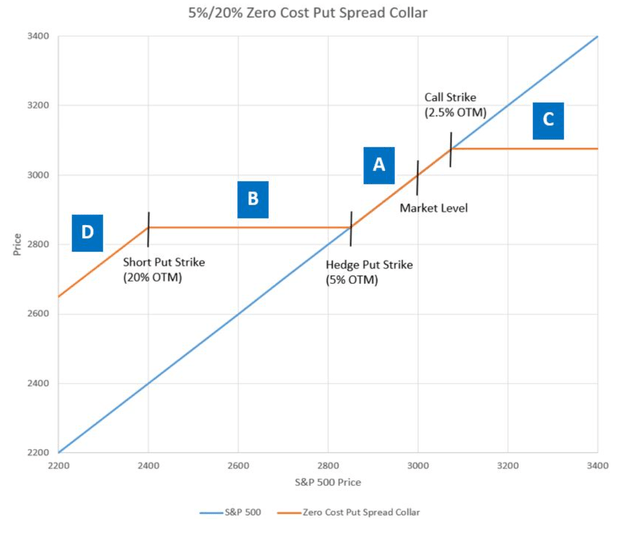
JHEQX And The Quarterly Rebalance
Due to the popularity of the strategy and the size of the JHEQX fund, its quarterly resets are now becoming market-moving events where traders pre-position for. For example, the S&P 500 Index fell 1.2% in the last hour of trading on March 31 without any news and some analysts pinned the move on options hedging flows related to the JHEQX fund. The JHEQX was also partly blamed for the market’s recent swoon towards the upper put strike (4210) heading into the September expiry.
To mitigate some of these hedging flows, the HEQT ETF deploys a ladder of put-spread collars over the rolling 3 sequential months, such that no particular expiration schedule becomes dominant like JHEQX’s.
Of course, the HEQT ETF is far from moving markets just yet, as it only has $110 million in assets at the moment (Figure 2). However, the combined impact of the many embedded option strategies in the marketplace should not be underestimated. The HEQT ETF charges a 0.53% expense ratio, similar to JHEQX’s 0.58%.
Figure 2 – HEQT fund overview (simplify.us)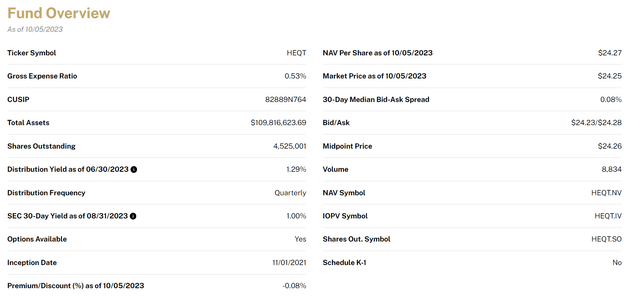
Portfolio Holdings
Figure 3 shows HEQT’s portfolio, which consist of a 97.8% weight in the IVV ETF, plus a ladder of put-spread collars with expiries ranging from October to December.
Figure 3 – HEQT portfolio holdings (simplify.us)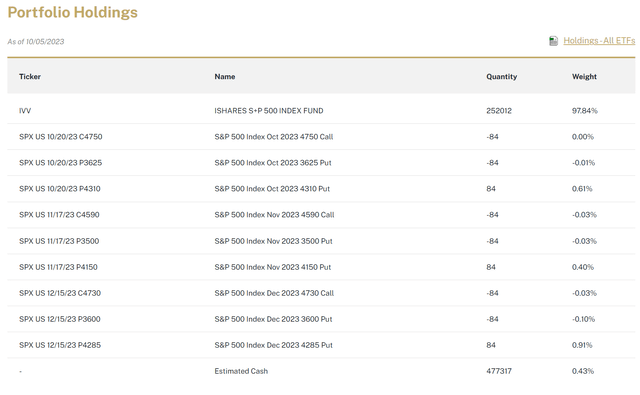
Distribution & Yield
The HEQT ETF pays a $0.08 / quarter distribution which works out to a 1.3% yield, similar to that of the S&P 500.
Returns
Figure 4 shows the historical returns of the HEQT ETF since inception. The fund outperformed the S&P 500 in 2022, declining 8.4% compared to 18% for the S&P. So far this year, it has returned 8.9% to October 5th, 2023, slightly less than the S&P 500’s 12.2% return.
Figure 4 – HEQT historical returns (morningstar.com)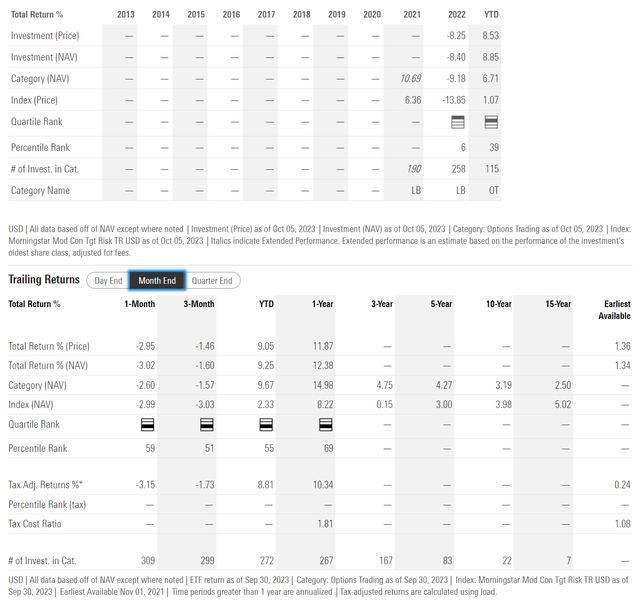
Instead of looking at just the historical and annual returns, it may also be useful to look at how the HEQT ETF performs on a day-to-day basis compared to the market.
HEQT Reduces Volatility
On a short-term YTD basis, the HEQT ETF has indeed underperformed against the IVV, as it has traded away some of its upside for downside protection against market drawdowns and the market has been mostly up (Figure 5).
Figure 5 – HEQT vs IVV, YTD basis (Seeking Alpha)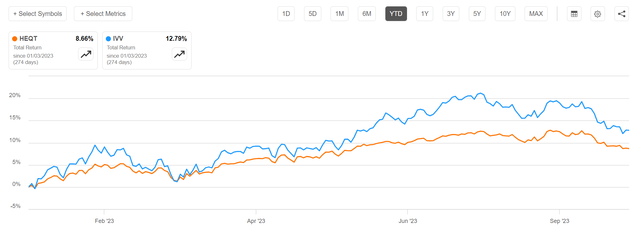
However, if we stretch the lookback farther, since inception, the HEQT ETF has outperformed the IVV as it did not suffer IVV’s large 2022 declines (Figure 6).
Figure 6 – HEQT vs. IVV, since inception of HEQT (Seeking Alpha)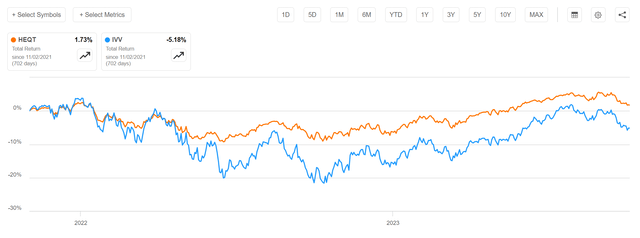
Finally, if we make the assumption that the HEQT performs essentially the same as JHEQX, we can see that JHEQX has significantly underperformed the IVV since its inception in 2014 (Figure 7). This is to be expected because the put-spread collar strategy essentially gives up part of its upside distribution in order to fund the put spread.
Figure 7 – JHEQX vs. IVV, since JHEQX inception (Seeking Alpha)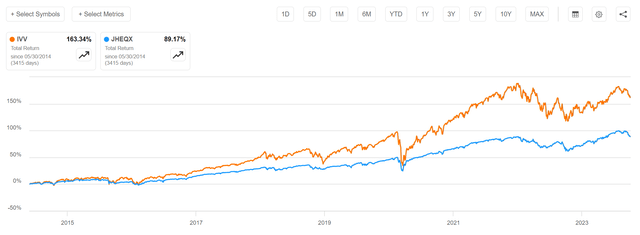
Overall, the HEQT ETF may be suitable for conservative investors who don’t mind trading away some upside to have peace of mind that their portfolio is protected from 5-20% drawdowns.
Risk To HEQT
Although the HEQT ETF is ‘protected’ from market drawdowns of 5-20%, if the market ‘crashes’ dramatically over a short period of time, the put-spread collar strategy could still suffer losses greater than 5%. For example, the JHEQX fund suffered an 18% peak to trough drawdown in the early days of the COVID-pandemic as the S&P 500 Index plunged more than 20% (Figure 8).
Figure 8 – Put-spread collar strategies can still lose more than 5% during large crashes (Seeking Alpha)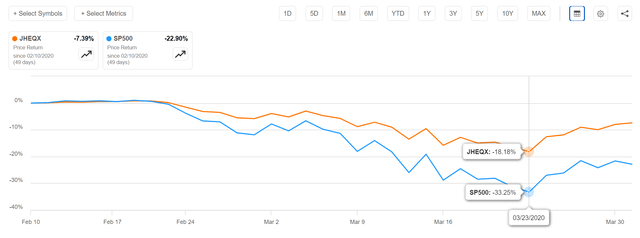
Conclusion
The Simplify Hedged Equity ETF from Simplify is a fund designed for conservatively-minded investors who don’t mind giving up some long-term upside to get protection from 5-20% drawdowns on the S&P 500. Historically, the HEQT ETF has performed as designed, outperforming the S&P 500 in 2022 while providing solid performance so far in 2023.
I rate the HEQT ETF a buy for conservative investors.
Read the full article here













